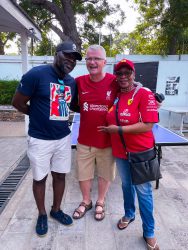- Ensure your people have the right mindset
“Culture eats strategy for breakfast” – These words of Peter Drucker, the renowned management guru of blessed memory, have proved timeless. If your culture is not in the right place, all your best efforts will be undermined as a consequence of wrong thinking and behaviour. Simply put, Employee experience and culture are critical to delivering the Experience brand. What we do for a living dictates how we see the world. It is not about how we are incentivised.
Therefore, for example, the young man or woman who runs the company’s IT systems has a mindset that is focused on the hard-concrete reality of data, and the look and feel of, say, a computer screen or a server. Trust me, I can relate to this assertion. Years ago, when I was running IT in my organization, my Finance Director always took a dig at me in meetings: saying “If you ask Kodwo how many computer units we need, he will say one hundred”.
My technical orientation at the time made me focus more on acquiring hardware and software assets without seriously considering the business requirements to justify the need for IT resources. In this kind of thinking, the subjective experience of customers is not important. In this kind of thinking, how we equate the relationship value to functional and hygienic factors is of very little importance. The focus is more on efficiency than what will make the customer satisfied: this is called ‘navel-gazing’.
Similarly, a CFO or CEO is most likely to say, “What is the return on customer experience? How much will it cost?” And above all else, “How can we save money by cutting costs?” In other words, culture and subjective experience are not of concern. In contrast to this thinking, when we weigh heavier on building relationships and developing loyal customers the essence of Customer Experience (CX) is better addressed! It should be more about the experience the customer has; everything else must come second to this!
Admittedly, sales growth and process efficiency are indispensable in business. However, all we are saying is this: with a clear view of what customer experience is, we have a great opportunity to gain an advantage over the competition. Therefore, let us endeavour to understand it and get the balance right. What route do companies with the experience brand take?
Steven Walden of TeleTech Consulting London, in his book CX Rebooted, recommends the following approaches among others to influence a mindset change in the organisation. First, change the corporate mindset; this must start with leaders’ actions and behaviours. Second, create a small, passionate, cross-functional CX Programme Team. Third, be customer advocates. Fourth, be consistent while maintaining flexibility; and fifth, promoting IT is not the answer alone.
Changing the corporate mindset
A workforce that is striving to meet the needs of its consumers is ensuring repeat business. Customers are the most important influencers in any business. The more your workforce engages with them, the less likely they are to contemplate switching to your competitors. Additionally, involving customers in the early stages of product and service development creates opportunities for collaborating innovatively with them. This allows the business to better-tailor its services to them and grow advocates exponentially.
Leadership must walk the talk, communicating their belief in experience throughout the organisation. The leadership of customer experience hinges on cooperation. This is necessary because customer experience thrives in environments where there is cross-silo (internal processes and functions) and cross-business co-creation. According to CX experts (drawing from the 80:20 principle), eighty percent of the leaders’ activity needs to be on the ground dealing with human issues; and 20% needs to be about the task itself.
Enhancing customer co-creation requires that ways of working to seep into process design, and team-building is within loose hierarchies to avoid creating a restrictive, myopic, bonus culture. it requires buy-in from the board level to influence the integration of customer needs into the core strategy, objectives and KPIs, thus creating a unified and interconnected company. Internal communications are imperative to dispersing the CX message. This way, the message is reinforced to employees over time and throughout the line of management.
Create a cross-functional CX Programme Team
Let’s consider this analogy from American football. It is the hand-off. This is essentially an exchange made by handing the ball to a teammate. This is based on the fact that a good understanding exists among teammates as they work toward the common goal of winning. The practical way to run CX in your business is to build a cross-functional programme that operates across business units and departments, with the common goal of delivering the best customer experience possible.
To reinforce the team effect, here are 4 steps recommended by Jeannie Walters – CEO and Founder of Experience Investigators, a global Customer Experience consulting firm. Develop a mission statement: this is a guiding statement for your organisation around what the experience should be for each customer, every time. It provides a consistent purpose around what the experience should be for your employees, whether they are interacting directly with customers or not.
Next, delegate CX roles to employees within a ‘CX bubble’ – a narrow range of departments or verticals. This at least allows for some cross-departmental collaboration. To make those in different departments value CX, make sure the goals are tied back to their objectives. Avoid the temptation to use exclusively customer-facing employees or those who otherwise directly interact with customers. Customer experience succeeds because all teams, right up to the top management level, recognise its importance and their role in it.
When building the cross-functional team, be sure that you include leaders who will have direct accountability over the most likely actions required to improve the customer journey, and also team members from other areas who are close to the customer experience (note that this may not only be customer-facing areas). To facilitate effective team-working, a team charter to help the CX team keep in alignment is recommended. Use a small team to keep them focused on specific issues. For example, a bank in Singapore originally had a small team of 15 highly focused on redesigning journey pain points, and this was in a big corporation with hundreds of thousands of employees.
Customer Experience is never done, it requires regular attention and action. This includes regular meetings to review CX issues. The exact frequency of meetings will vary from organisation to organisation, but it is crucial to establish the culture and ensure ‘stick-to-it-ism’ (my late father’s mantra… smile). A typical agenda for such meetings will encompass: a review and discussion of CX’s mission and goals; checking in on progress of CX programmes and priorities; reviewing customer feedback and insights; discussion of innovations and forecasting; and identifying next actions and accountabilities.
Customer advocates
Customer experience is about promoting the customer-first view and creating interconnections between departments and processes around this view. The truth is that there’s nothing wrong with silos. It is the interconnections between them through interactions and data which are important. Although we all need to think about the customer, in reality we need to facilitate appropriate levels of ‘think customer’ across the business. We are not in a perfect world, and CX is no exception to this reality!
CX, then, is that part of the organisation which takes the customers’ and employees’ side to balance the risk of companies myopically focusing on themselves, the business account, and closing down creative potential. We are the customers’ advocates at the top management level and through champions within the firm. Therefore, at the interface with top management we shouldn’t just recruit people from within our industry; we need to challenge thinking and depart from doing the same old same old.
Consistency and flexibility
Consider McDonald’s and Disney. Both are brands with clear direction and consistency in their approaches to business. They are clear about the fact it is what you do that matters; in other words, they focus on behaviours not measurements. Other brands are too strict in defining their criteria, hence they end up failing to evolve and see how markets change. Their lack of consistency to define and drive through a clear CX approach has ultimately affected them adversely. Finding this balance is crucial.
Who wants to work in a firm where there is no breathing room? Similarly, how many customers want to pay for an inconsistent brand experience wherein the experience in one store differs from the next one? If I walk into a branch of Shoprite or Melcom, I am looking for consistency.
A disjointed CX programmes is a complete put-off. One characteristic of a disjointed CX programme is that things are all over the place. There is a bit of support here, a bit of money there, a head of CX with no power but under the remit of the call centre manager, and so on. This does not help spread belief in the programme. Any CX environment without leadership traction will result in wasted efforts, and ultimately die from disillusionment.
Information Technology Alone is Not the Answer
IT systems provide us with capabilities to automate; that’s what they are there for! They are not a substitute for human understanding. Therefore, when we automate our journey-maps we must do well to leverage visual presentations and make them engaging. For example, use video and anything that will drive learning among employees. Don’t just automate in a big data solution; use the employees’ understanding of the experience, as well as the customer data that we can relate to from our interactions. These are more insightful. In other words, seek better data and not just big data.
It is critical to have the customer experience-eye on any IT implementation initiative. Unfortunately, heavy reliance on IT has led to commoditisation of the employee experience. For example, when we put stuff on our intranet site and make it 100 pages long when 2 pages would do. Furthermore, when we make any administrative activity a maze of IT systems – not because it benefits the employee but because it saves money. The value of IT in enhancing business performance cannot be underrated; however, it is important that IT serves as a useful complement to the experience and not a replacement.
Changing the corporate mindset to embrace customer experience is a game-changer. It must start with leadership actions and behaviour for buy-in at all levels. They have the power to influence mindsets, and mindset-change is the catalyst for changing the way of doing business.
Customer Experience Professionals Ghana presents the Annual Customer Experience Professionals Ghana Conference, a cross-industry meeting place bringing together over 300 global thought leaders, professionals and innovative solution providers in Ghana.
The theme for this year’s conference is ‘Accelerating Growth Through Customer Experience: The Case of Organisations and Industries’.
Date: Thursday 6th October 2022
Time: 09:00 a.m.
Venue: Labadi Beach Hotel, Accra, Ghana.
Contact 0552760129 – email:[email protected], online:www.cxpghana.com.
The Writer is a Management Consultant. He can be reached on 059 175 7205, [email protected],
https://www.linkedin.com/km-13b85717










